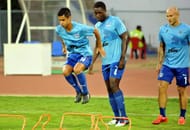Infrastructure
It was a pleasant surprise for all to see the lush green fields and much improved stadia. A renovated Cooperage(Mumabi), Sree Kanteerava(Bengaluru) , JN Stadium (Shillong), Fatorda Stadium(Goa) or even the makeshift Barasat stadium(Kolkata) had pitches far better than the patchy barren undulating surfaces one is used to see in Indian football .A natural surface is also being laid in the majestic salt Lake stadium.
Practice facilities of the teams are now almost at par with the best. BFC introduced GPS transmitters on their players to monitor various parameters like speed, distance covered etc. The introduction of quality support staff also saw lesser injuries and much fitter players. Transport and boarding facilities, ground and event management also improved greatly with the infusion of professionals.
Desi Power
It was probably for the first time in the history of I-league that foreigners did not rule the roost at Indian football. The emergence of fast and technically sound players like Thoi Singh, Jackichand Singh, Udanta Singh, Brandon Fernandes or Eugeneson Lyngdoh greatly reduced the dependence on foreign recruits. Though the top five goal scorers were still foreigners, almost all the assists were done by the desi brigade. Indian coaches/managers like Sanjoy Sen or Santosh Kashyap also outshone their foreign counterparts. There were many instances where foreign players were substituted by desi boys which is a rarity in India.
Regional Power shift
It was probably the worst I-league for the Goan teams. Churchill Brothers got banned due to licensing issues. Salgaocar FC, Sporting Clube de Goa or Dempo were consistently in the bottom five and finally the five times champions Dempo was relegated. On the other hand, Royal Wahingdoh FC(RWFC) changed the hitherto prevailing “also ran” image of north-eastern clubs. Consistent top class performances and giant killing acts saw RWFC finishing a comfortable and respectable third in its maiden I -league.

